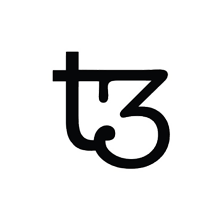
Tezos — платформа для смарт-контрактов, работа над которой началась еще в 2014 году. Tezos обладает рядом особенностей, которые выделяют ее среди других платформ:
- Возможность формальной верификации программного кода смарт-контрактов.
- Возможность обновления сети без выполнения разветвления (форка).
Tezos стремится построить блокчейн с развитой системой управления и внутренней экономикой токена, которые будут способствовать заинтересованности пользователей в принятии решений относительно функционирования и развития сети.
Tezos привлек широкое внимание общественности летом 2017 года и провел одно из наиболее успешных ICO, в ходе которого было собрано около $232 млн по курсу на тот момент. Осенью 2017 стало известно о конфликте руководителей проекта, после чего началась волна коллективных исков против проекта от ICO инвесторов. Основная сеть была запущена в сентябре 2018 года, примерно на год позже, чем было указано в первоначальной White Paper. Несмотря на пошатнувшуюся репутацию, проект постепенно развивается и достаточно высоко оценивается многими разработчиками.
Нативный токен блокчейна — Tezzies. Тикер токена — ХТZ.
На 2 августа 2019 общее количество токенов в циркуляции составляет 802,57 млн XTZ.
Tezos работает на базе инфляционной модели, при этом годовая инфляция должна составлять около 5,5% в год. Новые XTZ эмитируются в процессе создания новых блоков, при этом часть XTZ может уничтожаться в рамках штрафных санкций за недобросовестное поведение валидаторов. Подробнее в разделе “Механизмы обеспечения консенсуса”.
ICO проекта состоялось в июле 2017 года. В ходе ICO было продано около 607,8 млн токенов XTZ на общую сумму (по курсу на тот момент) около $232 млн. Всего в ICO приняли участие около 32’000 пользователей. Токены были созданы и распределены в момент создания генезисного (самого первого) блока в сети Tezos при запуске бета версии.
Согласно данным на сайте Tezos Foundation распределение токенов носило следующий характер:
- Участники ICO ~ 88,43% ( 607’489’040,89 XTZ);
- Ранние спонсоры и подрядчики ~ 0,46% (3’156’502,85);
- Tezos Foundation и Dynamic Ledger Solution, Inc. (DLS).
Токены XTZ могут использоваться по следующим направлениям:
- Участие в создании новых блоков: непосредственное участие пользователя или делегирование токенов (подробнее в разделе “Механизмы обеспечения консенсуса”).
- Участие в системе децентрализованного управления (подробнее в разделе “Встроенные механизмы и функции”).
- Использование в качестве платежного инструмента для передачи ценности.
- Оплата газа — единицы стоимости для уплаты комиссий. В Tezos, как и в Ethereum, используется газ (Gas) для уплаты комиссий. Газ переводится в XTZ, стоимость единицы газа устанавливает пользователь, при этом стоимость операции в газе известна. Подробнее о модели с использованием газа можно прочитать в анализе платформы Ethereum.
Стоит заметить, что некоторые проекты столкнулись с проблемами инфляции в виду неограниченной эмиссии. Например, в Ethereum неоднократно обсуждалось ограничение эмиссии, с внедрением в Ethereum нового протокола Casper планируется постепенное снижение вознаграждения за нахождение нового блока. Однако, в Tezos используется система ончейн управления, с помощью которого пользователи смогут внести свои предложения по изменению модели эмиссии, которые будут приняты в случае поддержки большинством пользователей сети.
Tezos работает на базе механизма консенсуса Liquid Proof of Stake (LPoS) — алгоритма, в котором новые блоки создаются случайно выбранным участником (делегатом) и одобряются 32 другими случайными участниками.
В Tezos вместо термина майнинг введен термин baking, обозначающий создание новых блоков, и, соответственно, baker вместо майнера. В русскоязычных материалах нередко можно встретить перевод “выпекание”, при этом майнеров называют “пекарями”.
Права на создание новых блоков распределяются между делегатами в зависимости от размера ставки этого участника в токенах, как в механизме консенсуса Proof of Stake.
Для повышения скорости выбора делегатов токены XTZ агрегируются в роллы (rolls), при этом 1 ролл = 8’000 XTZ. Роллы агрегируются на уровне делегатов и “мощность” делегата в токенах округляется снизу. То есть, если у делегата 8’000 XTZ, то у него есть 1 ролл, если 15’999 XTZ, то у него 1 ролл, а если 16’000 XTZ, то 2 ролла.
Так как не все участники сети могут быть заинтересованы в создании новых блоков (baking), в Tezos участник может делегировать свои токены другим участникам без передачи права собственности: делегат не может потратить токены. Делегированные токены становятся частью “ставки” делегата.
Для создания новых блоков из пула делегатов (пользователей владельцев нод Tezos, которые решили участвовать в процессе создания новых блоков) выбираются два типа участников:
- Создатели блоков (Baker) — 1 участник для каждого блока, который создает и подписывает новый блок.
- Подтверждающие узлы (Endorser) — 32 участника для каждого нового блока, которые подтверждают, что увидели и провалидировали новый блок.
За свою деятельность делегаты получают вознаграждение:
- 16 XTZ + комиссии создателю блока (baker).
- 2 XTZ за подтверждение узлам endorsers.
Таким образом, вознаграждение за создание нового блока составляет 80 XTZ.
Для повышения безопасности сети и снижения вероятности недобросовестной работы делегатов в Tezos используется гарантийный депозит (security deposit). Гарантийный депозит за создание каждого нового блока составляет 512 XTZ и 64 XTZ за подтверждение.
В Tezos блоки группируются в циклы, один цикл равен 4’096 блоков. Гарантийный депозит замораживается на время PRESERVED_CYCLES, которое равно пяти циклам в прошлом и составляет как минимум 14 дней, 5 часов и 20 минут. С учетом вероятности принятия участия в создании новых блоков при текущих параметрах сети делегат должен хранить в депозите около 8,25% от общего количества токенов, соответственно, делегату должно принадлежать более 8,25% от делегированных ему токенов. Подробнее в документации проекта и в статье на Medium.
Если делегат ведет себя недобросовестно, например, пытается создать два блока на одной высоте, это может быть замечено другими участниками сети. В этом случае участник, который обнаружил и предоставил свидетельства недобросовестной деятельности, получает половину гарантийного депозита в качестве вознаграждения, при этом вторая половина депозита сжигается.
В связи с тем что в алгоритме консенсуса используется делегирование, часто ошибочно указывается, что Tezos работает на базе Delegated Proof of Stake (DPoS), который используется, например, в EOS и TRON. Ранее в некоторых материалах Tezos использовалось обозначение “Proof of Stake with delegation”. Чтобы избежать путаницы было введено название Liquid Proof of Stake (LPoS). В статье на официальной странице Medium приводится сравнительная таблица DPoS и LPoS:
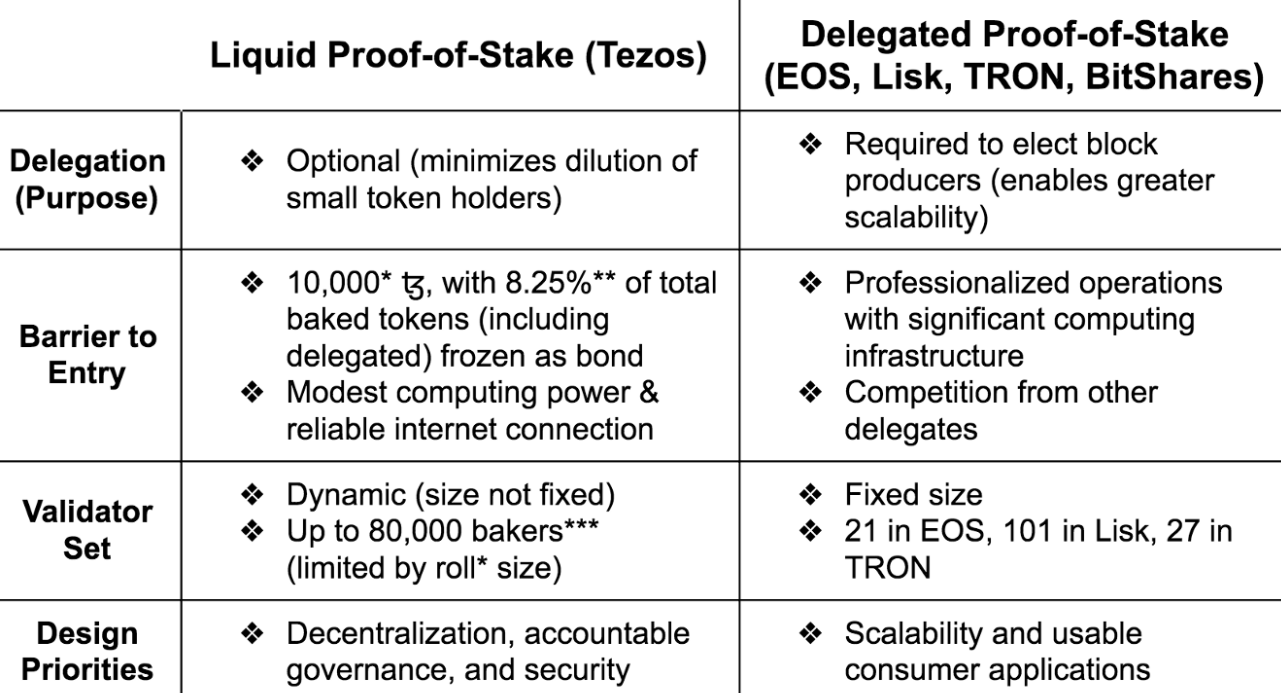
Несмотря на теоретически возможное большое количество валидаторов на текущий момент суточное количество разных создателей блоков составляет примерно 140 - 170, при этом их количество постепенно увеличивается:
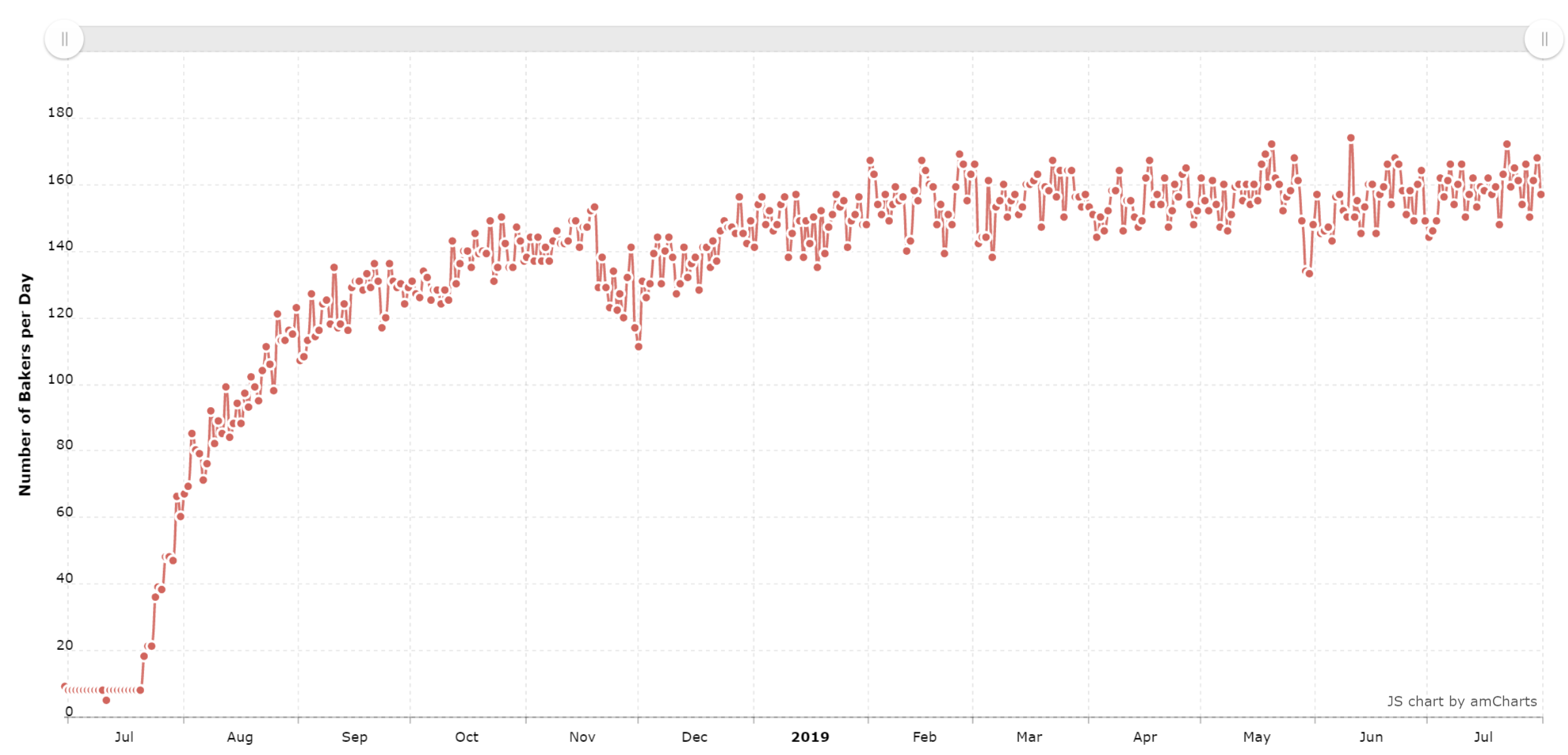
Стоит заметить, что в Tezos процесс выплаты части вознаграждений пользователям, которые делегировали токены на текущем этапе не автоматизирован. Выплаты проводятся в ручном режиме, публичные делегаты могут взимать комиссию, которая может отличаться в зависимости от сервиса.
Пользователь может предпочесть делегировать токены вместо того, чтобы самому становиться делегатом, если он, например, не готов поддерживать полную ноду Tezos и рисковать своими токенами, так как он должен будет сформировать депозит.
Однако, нужно учитывать, что, когда пользователь делегирует токены, он также делегирует свои голоса в рамках системы управления (подробнее в разделе “Встроенные механизмы и функции”).
Платформа Tezos написана на языке программирования OCaml, при этом для написания смарт-контрактов используется язык программирования Michelson.
В документации приведена обобщенная схема архитектуры Tezos:

Протокол, который изображен зеленым цветом на схеме, отвечает за интерпретацию транзакций и за выполнение других административных операций. Протокол отвечает за обнаружение неправильных блоков с ошибками. Протокол знает о существовании только одной основной ветки блокчейна, начиная с генезисного блока, и не подразумевает, что узлы могут предлагать альтернативные цепочки.
Оболочка (Shell), изображенная синим на схеме, знает о возможности наличия нескольких цепочек и отвечает за выбор предложений, поступивших от создателей блоков (baker). Оболочка выбирает и загружает альтернативные цепочки в протокол, чтобы тот проверил их на наличие ошибоки и присвоил абсолютную оценку. После этого оболочка выбирает валидную цепочку с наибольшей оценкой, эта часть оболочки называется валидатором (validator). Также оболочка содержит p2p слой, дисковую систему хранения блоков, операции для передачи данных блокчейна новым нодам и версионное состояние реестра.
RPC слой (Remote Procedure Call, сервис вызова удаленных процедур), изображенный желтым, является компонентом, поддерживающим формат JSON format и HTTP протокол, с помощью которого сторонние клиенты могут выполнять запросы и анализировать состояние узла.
Одна из наиболее важных особенностей Tezos — возможность протокола изменяться, улучшаться, эту особенность называют self-amending property. В протоколе реализованы две функции, которые могут устанавливать новую версию протокола в тестовую или основную сеть. Предложения по изменению сети могут вноситься с помощью системы управления (подробнее в разделе “Встроенные механизмы и функции”), при этом предложения могут содержать код, который на первом этапе устанавливается в тестовую сеть, а затем, после достаточной проверки может переноситься в основную сеть. Возможность изменения протокола в соответствии с потребностями сообщества должна способствовать минимизации количества форков и, соответственно, вероятности раскола сообщества.
Tezos работает с использованием криптографического алгоритма SHA 256.
В Tezos есть два типа аккаунтов:
- Originated account — аккаунты, которые могут содержать код и могут делегировать токены другому аккаунту. Адреса начинаются с KT.
- Implicit account / Manager — аккаунты, которые могут быть менеджерами для других аккаунтов и не могут выполнять код. Данные вид аккаунтов может стать делегатом и участвовать в LPoS. Адреса начинаются с TZ.
С помощью специальной операции из implicit аккаунта можно сделать originated аккаунт. Сравнительная таблица типов аккаунтов:
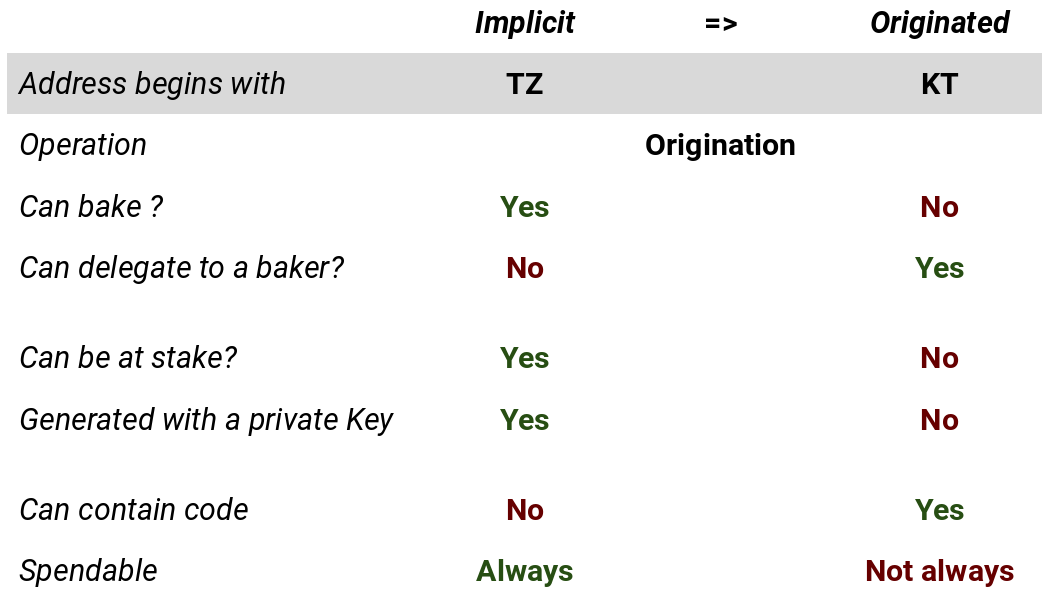
Фонд Tezos Foundation зарегистрирован в Цуге, Швейцария.
Осенью 2017 года после успешного завершения ICO стало известно о конфликте основателей проекта: в конфликте были задействованы компания разработчик и основатели проектаАртура и Кэтлин Брейтман и некоммерческий фонд Tezos Foundation, который контролирует доходы от крадусейла, под руководством Иоханна Геверса. Конфликт основателей привел к задержкам в работе над проектом и продемонстрировал неготовность руководства к грамотному целевому использованию средств, что в свою очередь вызвало недовольство участников ICO. В ноябре 2017 стало известно о подаче группового иска против связанных с Tezos компаний. Спустя несколько недель был подан новый групповой иск со схожими обвинениями: распространение незарегистрированных ценных бумаг и др. Судебные разбирательства до сих пор не закончены. В случае, если XTZ будет признан ценной бумагой, инвесторы получат право на возврат своих инвестиций в ходе ICO.
В июле 2018 года стало известно, что международная компания PwC проведет аудит финансов и операций Tezos. Вероятно, одной из целей проведения аудита всемирно признанным экспертом было укрепление доверия к проекту, которое пошатнулось в связи с трудностями после проведения ICO.
После запуска основной сети Tezos начался процесс получения токенов XTZ участниками ICO. При этом было введено обязательное прохождение процедуры KYC всеми пользователями. Стоит заметить, что, несмотря на судебные иски с обвинениями в нарушении законодательства о ценных бумагах США, ограничения на граждан США не накладывались, они также получили свою долю токенов.
Стоит заметить, что возможность делегирования токена XTZ c последующей получением вознаграждения юридически может трактоваться неоднозначно.
- Оценка «Архитектура и логика»: 6 баллов из 10. Прогноз нейтральный.
Механизм и принципы эмиссии – 2 балла из 3 (неограниченная эмиссия может привести к проблемам с инфляцией)
Блокчейн (архитектура и механизм обеспечения консенсуса) – 3 балла из 4 (отсутствие в протоколе автоматического распределения вознаграждений при делегации затрудняет справедливое распределение вознаграждений).
Лицензирование и юридические аспекты – 1 балл из 3 (риски, вызванные судебным процессом, связанным с проведением ICO)
Прогноз – нейтральный. В Tezos реализованы интересные модель механизма консенсуса и внутренняя экономика токена, которые способствуют вовлечению всех пользователей в обеспечение работы сети. Однако, судебные разбирательства формируют риски в случае признания принцип проведения ICO нелегитимным.
At the current stage, the Libra network operates in a prototype test mode and there are no specific figures on the network's working performance. The project documentation states that after the launch, it is expected to reach TPS 1000 and 10 second of confirmation time. It is assumed that many transactions will be carried out offchain with the use of payment channels – and thus the above performance values will suffice to ensure the operation of the network at the first stages. It is also worth mentioning that, at least at the first stage of the work of Libra, the members of the Association will be the validator nodes, who will have to provide high technical requirements for the launch of nodes for processing transactions.
The main goal of Libra is the formation of a global convenient payment system. The Libra cryptocurrency is the means of payments in the project, which will be fully backed by a reserve from a basket of low-risk currencies. Most cryptocurrencies have high volatility and are used as an instrument for speculation, and not as a means of payment. Stabilizing the cost of Libra by backing should facilitate its acceptance by users. Thus, the main function of Libra is the performance of payment transactions.
As well as Bitcoin, Libra is a pseudo-anonymous network in which the user does not have to verify his account and can have any number of cryptographic addresses that are not connected to each other.
The project documentation mentions the prospect of using offchain payment channels to reduce the load on the network, but the details of the planned implementation are not currently available.
Libra will support smart contracts, that will be written on Move programming language. It is assumed that at the first stage of the network operation, only pre-built smart contracts can be executed, which creates certain restrictions on network usage. The availability of ready contracts is convenient for users in case they cover the main demanded usage scenarios. However, currently there is no information about the available types of contracts. On the other hand, such an approach will be able to minimize the number of potential errors in contract codes, which theoretically could lead to the loss of funds and, thereafter, to deterioration of the project’s reputation.
It is planned that Libra will be managed with the use of votings, which, among other things, can be performed in onchain mode.
As of June 26, 2019, Libra has launched a test network, through which developers can familiarize themselves with the project, learn the new language Move, try to write their own smart contracts, etc. The platform code is available on github. The detailed documentation on working with the platform and with Move language is available for developers.
It is planned that the launch of the main network will take place in the first half of 2020.
Calibra will become a native wallet for Libra. Calibra is a subsidiary of Facebook, Inc. and operates independently of Facebook. Calibra wallet will be available as a separate application for Android and iOS, and will also be integrated into Facebook and WhatsApp messengers. It is planned that, at the first stage, the wallet will be primarily focused on p2p payments and will maintain the minimal functionality: QR codes, etc. In the future, integration with Point of Sale devices, etc. is planned to expand integration with the business. Calibra will require KYC procedures from users.
On the github of the project, you can find out more about the available APIs.
The main network of the project has not been launched yet and it is not yet known what special tools will be made for integration with other crypto projects.
- Оценка «Функционал и программная платформа»: 8 баллов из 10. Прогноз нейтральный.
Производительность и масштабируемость – 1 балл из 2 (невысокие показатели)
Встроенные механизмы и функции – 3 балла из 3
Продукт – 3 балла из 4 (отсутствие официальных кошельков с графическим интерфейсом для участия в голосованиях по обновлениям протокола затрудняет вовлечение пользователей сети в процесс)
Возможности интеграции – 1 балл из 1.
Прогноз – нейтральный. Tezos предоставляет пользователям инструменты, которые позволяют принимать решение об обновлении сети всеми пользователями децентрализованно. Однако, текущая реализация обладает потенциалом для развития. Стоит наблюдать, как будет развиваться функционал проекта и инструменты для работы с сетью.
По данным coinmarketcap на 9 августа 2019 XTZ представлен на 17 торговых площадках, при этом объем торгов распределен следующим образом:
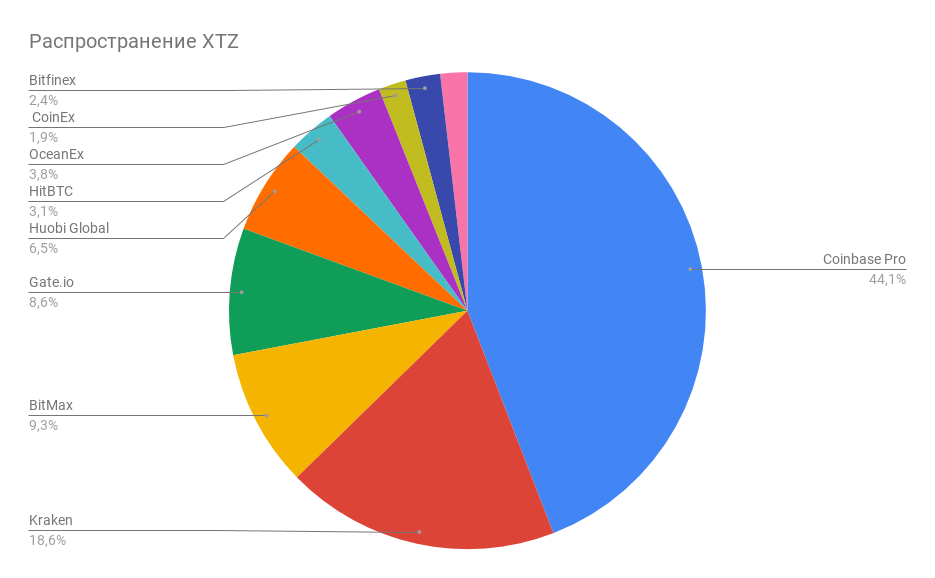
На 9 августа 2019 по данным coinmarketcap капитализация проекта составляет $923'458'384 /78'814 BTC, что ставит проект на 15 место в общем ТОПе криптопроектов.
По данным coinmarketcap максимальное значение капитализации было достигнуто 9 июля 2018, тогда капитализация составляла около $1,5 млрд. Однако, тот период относится к запуску бета версии сети и началу распределения токенов между участниками ICO. Токены только стали выходить на рынок и максимум был достигнут в период обвала стоимости. После достижения максимального значения наблюдался период повышенной волатильности и начало отрицательной динамике. В ноябре 2018 наступило резкое падение, коррелирующее с общим поведением рынка. В период с начала декабря до середины марта 2018 капитализация была сравнительно стабильна и в среднем составляла $220 –250 млн. В середине марта начался прирост капитализации и повышение волатильности.
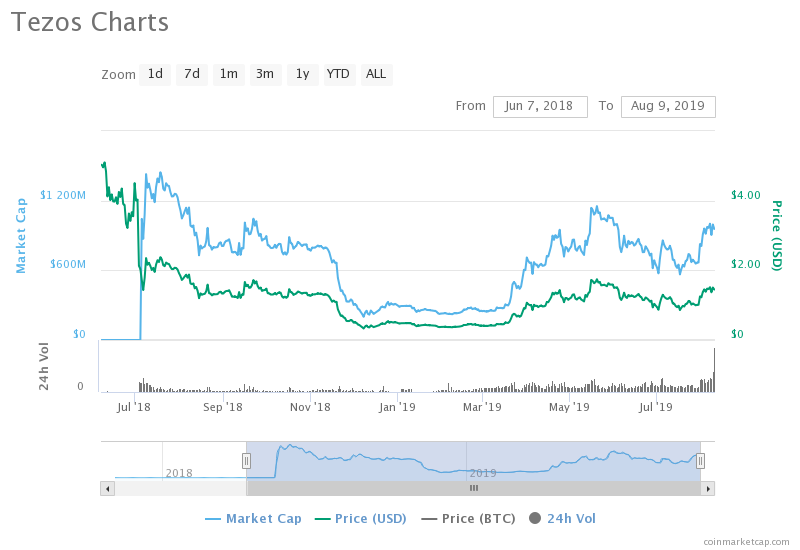
Также стоит заметить, что весной 2019 наблюдает прирост объема торгов, который коррелирует как с развитием проекта, так и с общими тенденциями рынка.
По данным coinmarketcap на 12 августа 2019 стоимость токена XTZ составляет $1,37 / 0,00012058 BTC.
До запуска сети и выпуска токенов XTZ на бирже Bitmex были представлены фьючерсы на XTZ и IOU на бирже HitBTC.
Максимум был достигнут в период общего подъема рынка в декабре 2017 года, при этом стоимость составила около $11,2. Выпуск токенов состоялся в начале июля 2018 года. До этого момента наблюдалась сильная волатильность. В преддверии запуска сети наблюдалось укрепление стоимости, однако, после ее запуска стоимость резко упала. Вероятно это связано с тем, что репутация Tezos была неоднозначной и многие пользователи решили продать купленные во время ICO токены сразу, как только это стало возможно. После резкого падения волатильность снизилась, но при это продолжился небольшой отрицательный тренд. В марте 2019 тренд сменился на положительный, возможно, это связано с запуском первого этапа работы системы управления, в результате которой были внесены изменения в протокол. Однако, к началу июля стоимость снизилась до прежнего уровня. Несмотря на отсутствие явной положительной динамики наблюдается увеличение объема торгов, коррелирующее с текущими тенденциями рынка.
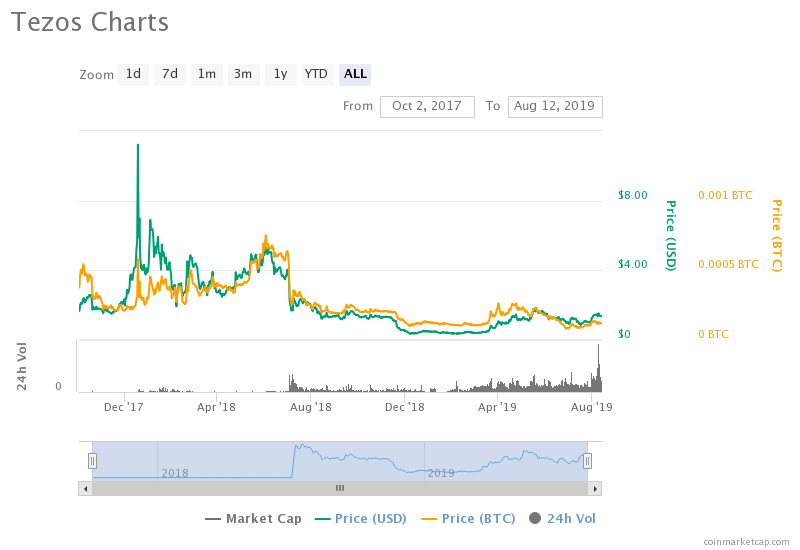
- Оценка «Статистика»: 5 баллов из 10. Прогноз нейтральный.
Распространение – 1 балл из 3 (небольшое количество площадок, почти половина объема торгов приходится на одну из них)
Динамика капитализации– 3 балла из 4 (повышение показателей, коррелирующее с движением рынка, рост объема торгов)
Динамика цены токенов – 1 балл из 3 (отсутствие сильной положительной динамики, риски снижения стоимости в связи с неограниченной эмиссией, зависимость от движений рынка)
Прогноз – нейтральный. Стоит следить за расширением количества торговых площадок, на которых представлен XTZ, и влиянием инфляции на статистические показатели.
On the official website of Libra, you can read the detailed documentation describing the basic principles of functioning of Libra:
- White Paper overview, describing the overall concept of the project.
- Technical White Paper.
- Technical documentation for developers..
- A document on the new programming language Move, created specifically for Libra.
- A document, describing LibraBFT consensus algorithm.
- Sections on the site, dedicated to the Libra Association, the Libra reserve.
Documentation allows to create a comprehensive view of the project, including the details of technical operation of the platform.
Road Map is not available in the public access. It is known only that the launch of the main network will take place in the first half of 2020.
- "Analysis of Road Map and White Paper" evaluation: 5 points out of 10. The outlook is neutral.
White Paper — 5 points out of 5.
Road Map — 0 points out of 5 (absent).
The outlook is neutral. The high quality of project documentation is leveled by the absence of the Roadmap.
The Libra blockchain and the reserve are managed by the Libra Association. The Libra Association is managed by the the Libra Association Council, which consists of representatives from each member of the Association. Members of the Association are large businesses, social and scientific organizations. The rules for joining the Association can be found on the official website.
Project management decisions will be made by voting, and the voting threshold may differ depending on the importance of the decision. Regardless of how many Libra or LIT tokens the member of the Association owns, his vote can be represented by the largest of: 1 vote or 1% of the total number of votes. Members of the Association whose voting weight is above the limit, can delegate their votes to the Libra Association Board for their redistribution, for example, to scientific or social organizations that cannot make investments of at least $10 million (threshold for entering the Association, more details on the link).
The document on the Libra Association describes the following roles, without indicating specific individuals:
- Managing Director. The MD is elected by the council every three years and manages the main project executive team responsible for the daily operation of the Libra Network.
- Deputy MD/COO, serving as the MD's replacement in absence; HR and administrative team.
- Chief Financial Officer — treasury and currency-exchange team, investor relations team.
- Head of Product — software and the Libra network management team; developer community management team.
- Head of Business Development — BD team, Founding Members relations team.
- Head Economist — economics team.
- Head of Policy — advocacy and communications teams.
- Head of Compliance and Financial Intelligence.
- General Counsel — legal team.
The initial group of organizations that will become members of the Association and will work on the final version of the Association's charter by industry:
- Payment systems: Mastercard, PayPal, PayU (Naspers’ fintech arm), Stripe, Visa.
- Technology companies and marketplaces: Booking Holdings, eBay, Facebook/Calibra, Farfetch, Lyft, MercadoPago, Spotify AB, Uber Technologies, Inc.
- Telecommunications: Iliad, Vodafone Group.
- Blockchain companies: Anchorage, Bison Trails, Coinbase, Inc., Xapo Holdings Limited.
- Venture Capital: Andreessen Horowitz, Breakthrough Initiatives, Ribbit Capital, Thrive Capital, Union Square Ventures.
- Non-profit organizations and academic institutions: Creative Destruction Lab, Kiva, Mercy Corps, Women’s World Banking.
It is planned that by the time of the initial launch in the first half of 2020, the Association will include about 100 participants.
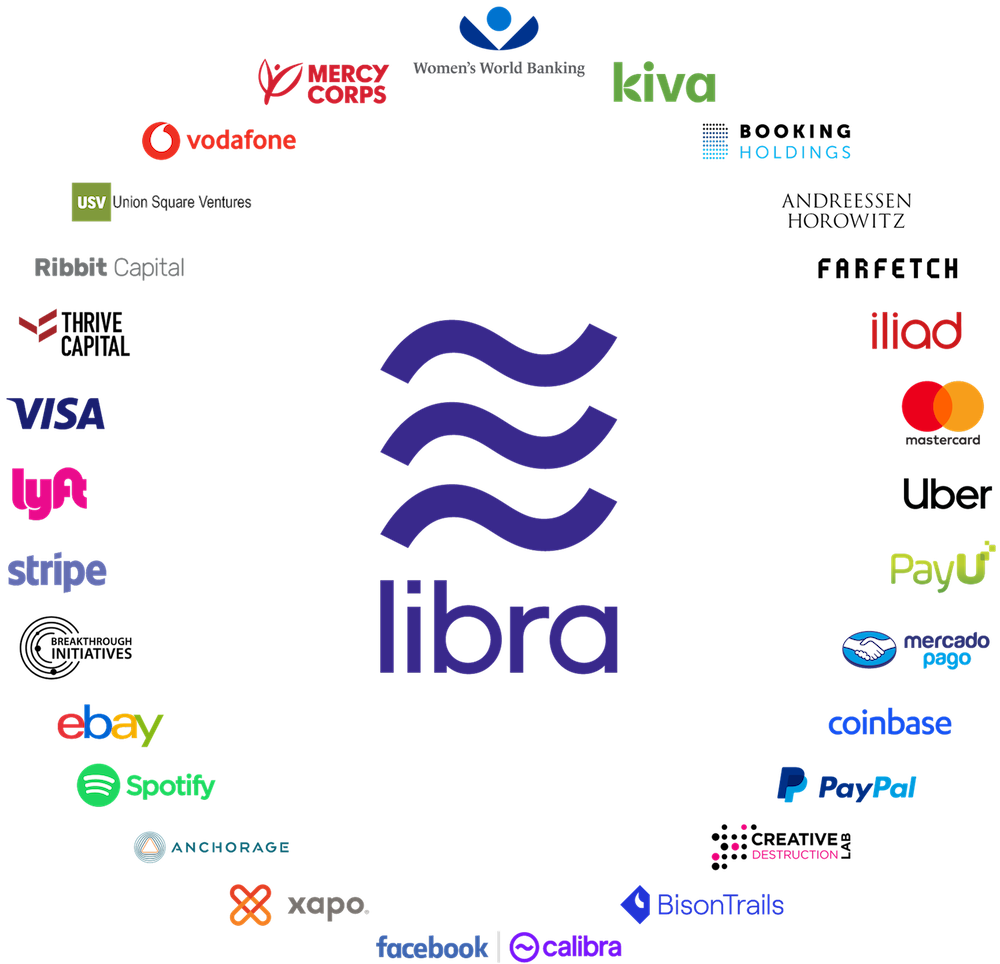
Initially, Facebook played a key role in the development of the project. It is assumed that until the end of 2019, Facebook will keep the leading role in the project, but after the launch of the Libra network, its rights and powers will be exactly the same as those of other members of the Association.
- "Analysis of the project team and affiliated persons" evaluation: 8 points out of 10. The outlook is positive.
The number of the team – 2 points out of 2.
Team structure – 2 points out of 3 (there is no information on the full structure of the team).
Team competencies – 2 points out of 3 (there is no information on the full structure of the team).
Affiliated persons – 2 points out of 2.
The outlook is positive. Despite the lack of full information on the structure of the team members, there is no doubt that the project will be supported by highly qualified specialized experts.
The goal of Libra is to form a global payment system using blockchain technology. Many crypto projects have similar goals and can theoretically be considered as competitors.
Bitcoin is the most well-known payment cryptocurrency, but its key difference is the open nature of the network. the Libra network is permissioned: only a special circle of members can be the validator on the network. It is planned that in the future the project will move to a public blockchain. Thus, at the current stage, Libra significantly stands out by these and, to some extent, it is more correctly to compare it with more usual payment systems – for example, with PayPal, and not with Bitcoin.
Such projects as Dash, Nano and many others seek to improve the capabilities of cryptocurrency by adding convenient tools to their wallets. In addition, for example, a decentralized project management system is being developed in Dash, which allows, on the one hand, to make decisions efficiently, and on the other, to maintain a decentralized anonymous working principle.
Another difference of Libra is the presence of the reserve that provides cryptocurrency, which should help to stabilize its value and to make it a more convenient payment tool, unlike most other cryptocurrencies with high volatility. From this point of view, Libra has more in common with stablecoins, the value of which is pegged to some stable asset, such as dollar or gold. Among such projects we can mention Tether, Digix, TrueUSD and others.
Another project to create a backed cryptocurrency by a large company is JPM Coin, launched by the American bank – JPMorgan Chase. The cost of JPM Coin is pegged to the US dollar, the coin will be used for transfers between large institutional clients, and not for end-user interaction.
First of all, the Libra project stands out by the largest number of potential users – Facebook social network clients (over 2.4 billion), who will receive embedded wallets in their messengers.
- "Competitors" evaluation: 5 points out of 10. The outlook is positive.
Direct competitors – 3 points out of 4 (there is competition).
Industry competitors – 2 points out of 4 (high competition).
Project monitoring of competition – 0 point out of 2 (absent).
The outlook is positive. Despite the presence of competition in the industry, Libra has chances to become one of the most used cryptocurrency means of payment.
Citation, social networks
The Libra project is one of the most talked about crypto projects in the community. Despite the fact that the release of documentation and the test network took place quite recently – in the middle of June 2019 – almost all media published their reviews on the project. Every day a greater amount of news appear, related to Libra. Libra is the first example of launching a corporate cryptocurrency for mass use by such large companies, which in a logical way attracted the maximum attention of not only the crypto community, but also of the world as a whole.
The popularity of social accounts on June 27, 2019:
- Twitter — 22.4 thousand subscribers.
- Facebook — 9.6 thousand subscribers.
- Instagram — 6.4 thousand subscribers.
A small audience in the social accounts of the project is due to the fact that the official announcement of Libra took place less than 2 weeks ago.
Applicability
On June 27, 2019, the Libra network operates in the test mode, therefore, there is no real activity and use of cryptocurrency.
Projects working with Libra
The Libra project was launched by Facebook social network with the participation of a great number of large companies. The native wallet Calibra will be integrated with Facebook, WhatsApp messengers and Instagram. Thus, a multi-billion audience of these projects will receive an access to cryptocurrency after its launch in 2020.
The Libra Association includes a great number of large companies (for more details, see “Analysis of the project team and affiliated persons” section) from different industries, and their number will increase. Currently, it is not known how they will use Libra cryptocurrency in their services. It also became known that some members joined the Association on the condition that they would not promote the project and use cryptocurrency directly in their services, as regulators in many countries expressed a negative opinion regarding Libra.
Information about the integration of Libra with other independent projects is not yet available.
Famous persons in the team
Despite the lack of indication of specific individuals in the project team, the Libra Association includes the most recognizable international companies.
- "Fame of the project" evaluation: 6 points out of 10. The outlook is positive.
Citation, social networks – 3 points out of 3.
Usability / distribution – 0 points out of 2 (the main network has not been launched yet).
Projects based on technology – 1 point out of 3 (despite the lack of details on the integration of Libra cryptocurrency with members of the Association, it is likely that some of them will use Libra).
Famous persons in the team – 2 points out of 2.
The outlook is positive. “Facebook cryptocurrency” will undoubtedly be a widely discussed project and will increase its popularity. It is especially important to monitor how its real audience will grow after launch and the number of services integrating Libra.
The launch of Libra has caused a strong and ambiguous reaction in the community. On the one hand, launching a cryptocurrency of this magnitude can significantly increase the audience of cryptocurrency users and affect the financial services sector, making cryptocurrency payments much more accessible for users around the world. On the other hand, at the first stage Libra will work on the basis of a permissioned blockchain, which will be managed by a narrow circle of companies, which does not comply with decentralization principles and transparency accepted in the crypto community. Libra may turn out to be an unstable to censorship project.
However, the project documentation states the intention to make the Libra network public in the future. But at the moment there is neither a complete concept of the network operation in public mode, nor the time stamps of the planned transition.
Another concern of users is the ambiguous reputation of Facebook social network, which at the current stage is playing a leading role in the development of Libra. Facebook has come across several large-scale user data leaks and it’s unclear if the story will happen again. Also, Facebook is often accused of collecting users’ data and using it for its own purposes, the prospect of disclosure and/or monetization of data on users' financial transactions is perceived negatively.
Calibra wallet will work not only as an independent application, but also as a component of Facebook Messenger and WhatsApp and will require KYC procedures. A large amount of personal data is stored in the social accounts of Facebook users; therefore, it is not clear whether the proper protection of the confidentiality of financial data can be ensured in the case of a direct link between the wallet and the social account. The centralized storage of social and identification data of users in combination with the history of their payments causes many concerns. The crypto community, which seeks decentralization and equality of participants, is skeptical about the emergence of a “monopolist” in the name of Libra.
Another potential risk of the project is the attitude of the regulators. Despite the desire of the project to meet the requirements of regulators, it is unclear how the world will perceive a cryptocurrency with such influence, especially given the fact that this area is still relatively young and the legal field in different jurisdictions is different, and in many has not even been formed. Many governments are wary of the launch of Libra: US congressmen called on Facebook to suspend the work on Libra, Chairman of the State Duma Committee on the Financial Market Anatoly Aksakov has stated that in Russia Libra would not be legalized, etc.
Despite the presence of a large number of fears, many experts positively perceive the launch of Libra, because it can give a strong push to the development of the industry and give access to cryptocurrencies to a huge audience.
- "Trust index" evaluation: 7 points out of 10. Scam probability: below average.
Scam probabiliry is below average. Despite a large number of fears in the community, Libra should be perceived, at least at the current stage, not as a replacement for Bitcoin and a fully independent decentralized project, but as a predominantly corporate solution, which, despite certain shortcomings, can be a step towards mass acceptance of cryptocurrency as a form of payment and the blockchain as a valuable technology. However, one of the main risks at this stage is the negative attitude towards the project in regulatory authorities.
RATING. “Libra” evaluation: 44 points out of 70 – 62.86%. The outlook is neutral.
The outlook is neutral. Libra can not be called cryptocurrency in the full sense of the word because of its corporate nature. However, the project has a number of advantages, including the well-known and authoritative representatives of the Association, as well as the enormous size of the potential audience that can revolutionize the financial sector. It’s definitely worth monitoring the launch of the main network, the acceptance of the project by both users and regulatory structures, as well as the fulfillment of the project promises to switch to a public blockchain. Libra should not be perceived as, for example, a Bitcoin competitor, since at the current stage this project is more like something between classical payment systems and open cryptocurrencies.
Libra is a “corporate” cryptocurrency, backed by a basket of stable currencies launched by large corporations with the main participation of Facebook social network. The project aims to create a global and accessible worldwide payment system. At the same time, instruments for working with Libra cryptocurrency will be integrated into the most popular social applications. Libra can be a compromise between fully decentralized cryptocurrencies and current banking payment systems.
The advantages of the project include:
- The authority and competence of the companies at the head of the project.
- Availability of the test network and instruments for developers.
- High-quality project documentation.
- Availability of collateral in Libra cryptocurrency, which helps to reduce volatility.
- Large coverage of potential user audience.
The disadvantages include:
- The operation on the basis of a permissioned blockchain.
- The lack of details of the planned transition to an public network, including the principles of PoS algorithm and validator fees.
- Centralized approach.
- Negative attitude of regulators in many countries.
- The mandatory KYC in the own wallet can be perceived negatively by some users.
- Absence of the Road Map with a detailed development plan.
References
Official website: https://libra.org
Technical documentation: https://developers.libra.org
Github: https://github.com/libra
Twitter: https://twitter.com/libra_
Facebook: https://www.facebook.com/LibraAssociation/
Instagram: https://www.instagram.com/libra/
